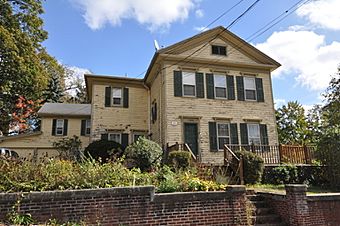Hillside Historic District (Waterbury, Connecticut) facts for kids
Quick facts for kids |
|
|
Hillside Historic District
|
|
 |
|
| Location | Roughly bounded by Woodlawn Terr., W. Main, and Willow, Waterbury, Connecticut |
|---|---|
| Area | 106 acres (43 ha) |
| Architect | Multiple |
| Architectural style | Mid 19th Century Revival, Late 19th And 20th Century Revivals, Queen Anne |
| NRHP reference No. | 87001384 |
| Added to NRHP | August 20, 1987 |
The Hillside Historic District in Waterbury, Connecticut is a special area. It's about 106 acres big. It was added to the National Register of Historic Places (NRHP) in 1987. This means it's an important historical place.
This district is a neighborhood with many homes. It's just north of Waterbury's main downtown area. The district has clear boundaries. West Main Street is to the south. Willow Avenue, Cliff Street, and Frederick Street are to the west. Buckingham Street and Woodland Terrace are to the north. Cooke Street is to the east.
Most of the buildings in the district were built between 1840 and 1920. This means you can see many different building styles from the 1800s and early 1900s. For a long time, Hillside was a very popular place to live. Many important people from Waterbury lived here. In 1987, there were 395 buildings that helped make the area historic. Two important buildings here are the Wilby High School and the Benedict-Miller House. Both are also listed as historic on their own. The Benedict-Miller House property was once home to The University of Connecticut's Waterbury Branch until 2003.
Contents
Architectural Styles in Hillside
The Hillside Historic District shows off many different building styles. These styles tell us about the history of building design.
Early Homes and Styles
The oldest houses in the district are in the Greek Revival style. You can find these along West Main and Cooke Streets. These were the main roads back then.
Popular Victorian Designs
Many houses in the district are in the Queen Anne style. This style was very popular when Waterbury was growing fast in the late 1800s. You can also see some earlier Victorian styles. For example, there's a beautiful Gothic Revival house at 63 Prospect Street. An impressive Italianate house is at 36 Buckingham Street.
Later Revival Styles
There are also many Colonial Revival and Tudor Revival houses. These are especially common along Prospect Street and Woodlawn Terrace. These styles brought back older looks.
Other Important Buildings
The district isn't just homes. It also has other important buildings. The Driggs School building was built in 1889. It is located on Woodlawn Terrace. There are also two churches built around 1917. These are the Baptist and Christian Science churches.



